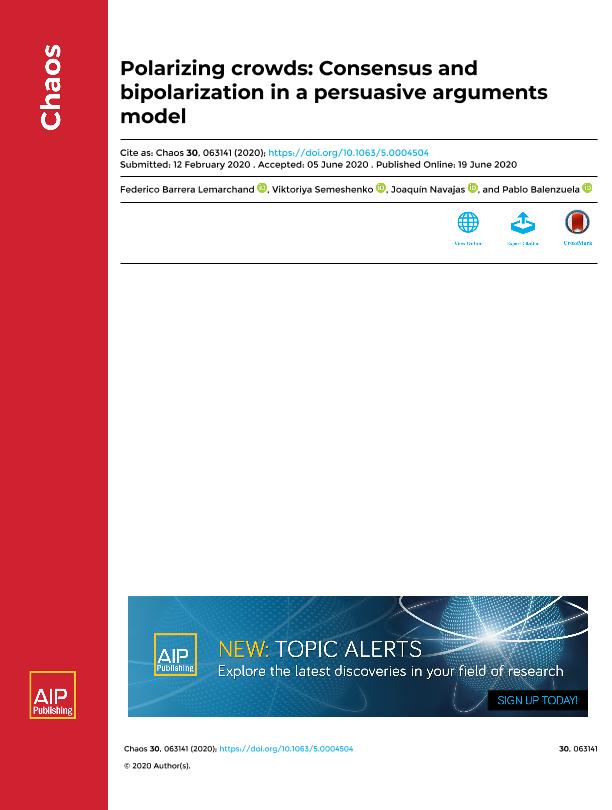Mostrar el registro sencillo del ítem
dc.contributor.author
Barrera Lemarchand, Federico Ulises

dc.contributor.author
Semeshenko, Viktoriya

dc.contributor.author
Navajas, Joaquín
dc.contributor.author
Balenzuela, Pablo

dc.date.available
2021-11-05T17:02:08Z
dc.date.issued
2020-06
dc.identifier.citation
Barrera Lemarchand, Federico Ulises; Semeshenko, Viktoriya; Navajas, Joaquín; Balenzuela, Pablo; Polarizing crowds: Consensus and bipolarization in a persuasive arguments model; American Institute of Physics; Chaos; 30; 6; 6-2020; 1-12
dc.identifier.issn
1054-1500
dc.identifier.uri
http://hdl.handle.net/11336/146153
dc.description.abstract
Understanding the opinion formation dynamics in social systems is of vast relevance in diverse aspects of society. In particular, it is relevant for political deliberation and other group decision-making processes. Although previous research has reported different approaches to model social dynamics, most of them focused on interaction mechanisms where individuals modify their opinions in line with the opinions of others, without invoking a latent mechanism of argumentation. In this paper, we present a model where changes of opinion are due to explicit exchanges of arguments, and we analyze the emerging collective states in terms of simple dynamic rules. We find that, when interactions are equiprobable and symmetrical, the model only shows consensus solutions. However, when either homophily, confirmation bias, or both are included, we observe the emergence and dominance of bipolarization, which appears due to the fact that individuals are not able to accept the contrary information from their opponents during exchanges of arguments. In all cases, the predominance of each stable state depends on the relation between the number of agents and the number of available arguments in the discussion. Overall, this paper describes the dynamics and shows the conditions wherein deliberative agents are expected to construct polarized societies.
dc.format
application/pdf
dc.language.iso
eng
dc.publisher
American Institute of Physics

dc.rights
info:eu-repo/semantics/openAccess
dc.rights.uri
https://creativecommons.org/licenses/by-nc-sa/2.5/ar/
dc.subject
Formacion de opinion
dc.subject
Modelos de agentes
dc.subject
Intercambio de argumentos
dc.subject.classification
Otras Ciencias Físicas

dc.subject.classification
Ciencias Físicas

dc.subject.classification
CIENCIAS NATURALES Y EXACTAS

dc.title
Polarizing crowds: Consensus and bipolarization in a persuasive arguments model
dc.type
info:eu-repo/semantics/article
dc.type
info:ar-repo/semantics/artículo
dc.type
info:eu-repo/semantics/publishedVersion
dc.date.updated
2021-09-07T18:28:53Z
dc.journal.volume
30
dc.journal.number
6
dc.journal.pagination
1-12
dc.journal.pais
Estados Unidos

dc.journal.ciudad
New York
dc.description.fil
Fil: Barrera Lemarchand, Federico Ulises. Universidad Torcuato Di Tella; Argentina. Universidad de Buenos Aires; Argentina. Consejo Nacional de Investigaciones Científicas y Técnicas; Argentina
dc.description.fil
Fil: Semeshenko, Viktoriya. Consejo Nacional de Investigaciones Científicas y Técnicas. Oficina de Coordinación Administrativa Saavedra 15. Instituto Interdisciplinario de Economía Política de Buenos Aires. Universidad de Buenos Aires. Facultad de Ciencias Económicas. Instituto Interdisciplinario de Economía Política de Buenos Aires; Argentina
dc.description.fil
Fil: Navajas, Joaquín. Universidad Torcuato Di Tella; Argentina
dc.description.fil
Fil: Balenzuela, Pablo. Consejo Nacional de Investigaciones Científicas y Técnicas. Oficina de Coordinación Administrativa Ciudad Universitaria. Instituto de Física de Buenos Aires. Universidad de Buenos Aires. Facultad de Ciencias Exactas y Naturales. Instituto de Física de Buenos Aires; Argentina
dc.journal.title
Chaos

dc.relation.alternativeid
info:eu-repo/semantics/altIdentifier/url/https://aip.scitation.org/doi/10.1063/5.0004504
dc.relation.alternativeid
info:eu-repo/semantics/altIdentifier/doi/https://doi.org/10.1063/5.0004504
Archivos asociados
